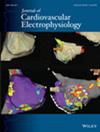摘要
背景:Valsalva (asv)主动脉窦内离散预电位(DPPs)被认为是室性早搏(PVCs)消融的可靠靶点。然而,消融仍可能失败,需要进一步研究。本研究旨在探讨asv内室性早搏消融失败的电生理特征和消融方法,尽管确定了dpp。方法和结果:在6个中心连续入组行室性早搏消融需要左心室流出道测绘的患者。纳入标准包括在asv中存在可重复的DPPs,以及asv内最早在左心室之前激活。根据ASV内消融结果将患者分为ASV组和非ASV组。780例接受评估的患者中,40例(年龄47.5±19.4;17例男性纳入最终分析,10例非asv组。ASV组DPP-QRS发病间隔(DPP-QRS)明显高于非ASV组(44.3±6.7 ms vs 15.0±5.0 ms, p 2 = 0.618, p = 0.007)。在22个月的随访中,非asv组中有1例患者复发。结论:在asv内定位的dpp,尽管是最早的位点,但并不一定代表室性早搏的靶点。建议采用DPP-QRS间期的瓣下方法Background
Discrete prepotentials (DPPs) mapped inside aortic sinuses of Valsalva (ASVs) are deemed as reliable targets for ablation of premature ventricular contractions (PVCs). Nevertheless, ablation may still fail, necessitating further investigation. This study aimed to investigate the electrophysiological features and ablation approaches for PVCs with failed ablation inside ASVs, despite identified DPPs.
Methods and Results
Patients undergoing PVCs ablation requiring left ventricular outflow tract mapping were consecutively enrolled at six centers. Inclusion criteria comprised the presence of reproducible DPPs in ASVs and the earliest activation inside ASVs preceding the left ventricle. Patients were divided into ASV and non-ASV groups based on ablation outcomes within ASVs. Of 780 assessed patients, 40 (age 47.5 ± 19.4; 17 males) were included in the final analysis, with 10 in the non-ASV group. The interval from DPPs to QRS onset (DPP-QRS) in the ASV group significantly exceeded that in the non-ASV group (44.3 ± 6.7 ms vs. 15.0 ± 5.0 ms, p < 0.001). A DPP-QRS interval < 25 ms perfectly differentiated non-ASV from ASV cases. Successful ablation beneath ASVs was achieved in all non-ASV patients, despite the local potential preceding the QRS onset by only 2.3 ± 8.0 ms. In the non-ASV group, the distance between locations of targets and DPPs was 13.3 ± 4.2 mm, negatively correlated with the DPP-QRS interval (R2 = 0.618, p = 0.007). Over a 22-month follow-up, one patient in the non-ASV group had recurrence.
Conclusion
DPPs mapped inside ASVs, despite being the earliest sites, do not necessarily represent PVCs targets. An infra-valvular approach is suggested with a DPP-QRS interval < 25 ms.

 求助内容:
求助内容: 应助结果提醒方式:
应助结果提醒方式:


